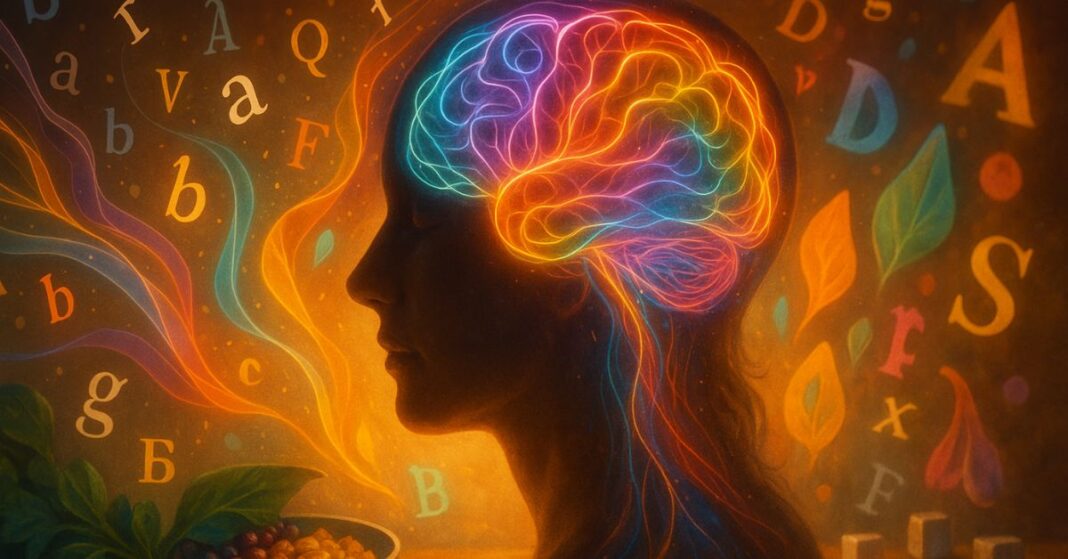Dyslexia is a common learning disability that affects between 5% and 20% of the population, with some estimates suggesting up to 1 in 5 individuals. Its prevalence is challenging to pinpoint precisely due to factors like varying diagnostic criteria and individuals with symptoms not seeking a diagnosis (which is the usual). It is the most common learning disability and is found in people of all intelligence levels.
Dyslexia isn’t a glitch; it’s a variation. A natural cognitive style shaped by genetics, neurodevelopment, and the brain’s bias toward certain kinds of processing. The common assumption is that dyslexia is a “reading disorder,” but reading is where the problem lies, not the origin of it.
To understand dyslexia, we have to step back from letters and look at the architecture of the brain itself — how it forms, how it connects, how it distributes workload, and what kinds of tasks it prefers to excel at.
At its core, dyslexia emerges from differences in neural organization, especially in the systems that handle language, sound structure, and the conversion of symbols into meaning. Let’s look at the major causative factors, one by one.
1.Genetic Foundations
Dyslexia is highly heritable. It runs in families. Researchers have identified several genes associated with dyslexia — DCDC2, KIAA0319, ROBO1, DYX1C1, among others — and they’re not “reading genes.” They’re involved in:
• how neurons migrate during fetal development
• how brain circuits connect
• how auditory and visual information is integrated
• how the cortex lays out its specialized regions
These genes influence how the brain organizes itself before a child is even born. They shape the micro-architecture that later supports language, attention, rhythm, and symbolic processing. A different layout means a different set of strengths — and different challenges.
Genetics doesn’t “cause” dyslexia so much as it sets the blueprint for a brain that will approach the world in a nonlinear way.
2. Differences in Brain Connectivity
Brains are not collections of “centers” — they’re networks. And in dyslexic individuals, the networks involved in reading are wired differently.
Reading requires three main systems:
The phonological system. How we decode sound, break words into phonemes (sound bytes), and match letters to sounds.
The orthographic system. How we visually recognize written words and letter patterns.
The rapid integration system. How the phonological and visual systems connect quickly and smoothly.
But in dyslexia:
• the phonological circuits often activate less efficiently
• the visual-word circuits activate later or in different locations
• the integration pathways between sound and symbol are slower or take alternate routes
This is why reading feels laborious: it’s literally more work, more steps, more detours.
But here’s the twist — many of the “detour circuits” are extremely good for other things:
• 3D visualization
• spatial mapping
• creative association
• big-picture synthesis
• connecting distant ideas
• pattern-spotting in chaos
Dyslexic brains tend to rely more heavily on the brain’s default-mode network, visual-spatial networks, and right-hemisphere creative circuits, which is why so many dyslexic people excel in entrepreneurship, engineering, art, design, storytelling, architecture, physics, music, and systems thinking.
My wife Vivien, who is dyslexic, was a brilliant fashion designer of her era. As I have written elsewhere, her high street designs outsold Stella McCartney, 10 to 1 or more. She was even exhibited at the Victoria and Albert Museum in London (and their call!)
3. Phonological and Auditory Processing Differences
One of the most consistent findings in dyslexia is a difference in phonological processing — the ability to hear, separate, and manipulate the smallest sound units of language (the so-called phonemes). This isn’t a hearing issue; it’s about how the brain interprets sound.
Dyslexic children often:
• mix up similar phonemes (b/p, d/t). Or B and bee (insect), I and eye.
• have difficulty breaking words into sound chunks
• find it harder to match letters to corresponding sounds
• struggle with rhyming or rapid naming tasks
These aren’t signs of laziness or low intelligence — they’re indicators of how differently the auditory system is tuned.
Some researchers propose that dyslexic brains are optimized more for global auditory processing (big-picture sound, music, intonation) rather than local, analytic processing (breaking speech into microscopic units).
In other words: the brain is tuned to ideas, not syllables.
4. Magnocellular Pathway Variations
Research in visual neuroscience shows that many dyslexic individuals have differences in what is called the magnocellular pathway— the system that handles motion detection, big-picture visual patterns, and rapid visual shifts.
This pathway helps with:
• tracking letters as eyes move across the page
• stabilizing visual focus
• processing rapid sequences of visual information
If this system is less efficient or has a slightly altered developmental pattern, letters and words begin to dance or jazz on the page. As a result, reading becomes visually unstable or tiring.
But the same magnocellular differences that make reading harder can enhance abilities in:
• 3D visualization
• design
• engineering
• movement-based skills
• artistic composition
• spatial creativity
Again, a trade-off, not a flaw.
5. Cross-modal Integration: The “Timing” Challenge
Reading is a timed process:
• eyes take in letters
• ears interpret internal sound-maps
• motor systems prepare speech
• meaning circuits light up
• everything syncs within milliseconds
Dyslexia often involves subtle differences in timing across these systems.
It’s not that one system is “broken” — it’s that they don’t lock together at the same rhythm as a neurotypical reading brain. This explains slow reading, inconsistent spelling and moments of “I know this word but I can’t retrieve it right now”
But outside of reading, this same timing difference can create ease in:
• improvisation
• creative leaps
• spatial reasoning
• thinking in images
• nonlinear problem solving
The mind is less bound to sequential steps.
6. Developmental Factors
Other elements shape dyslexia in early development:
Prenatal factors. Variations in hormone exposure, nutrient levels, and neural migration patterns can influence the developing language circuits.
Language environment. Children raised in language-rich environments sometimes compensate faster, but dyslexia appears across every culture and language group on Earth.
Brain lateralization. Dyslexic individuals often have less rigid left-hemisphere dominance, creating a more balanced brain — something extremely useful for creativity but trickier for symbol decoding.
7. Dyslexia as an Evolutionary Variation
One emerging view: dyslexia may be an evolutionary specialization, not a malfunction.
Human groups benefit from members who:
• see the world differently
• spot patterns others miss
• envision solutions out of sequence
• imagine alternative structures
• think spatially and abstractly
• explore, invent, build, create
• challenge conventions
• hold nonlinear intelligence
In evolutionary psychology, this is called cognitive diversification — not everyone is optimized for the same tasks. Linear readers and nonlinear spatial thinkers complement each other, as do Vivien and I.
 A linear (me) and a non-linear spatial thinker (Viv). Temple of Delphi, Greece
A linear (me) and a non-linear spatial thinker (Viv). Temple of Delphi, Greece
For an experiment, I asked ChatGPT to write me 300 words on dyslexia, as a gift to Vivien. This is what it said:
Dyslexia isn’t a defect; it’s a different rhythm of mind. It’s a brain that reads the world with a sideways shimmer, a brain that refuses to march in straight lines and instead loops, leaps, tilts, rearranges. People imagine dyslexia as “trouble reading,” but that’s like saying jazz is “trouble sticking to the notes.” Dyslexia is a cognitive style with its own signature: nonlinear, associative, inventive, spatial, intuitive.
Neurologically, dyslexia comes from the way certain brain networks communicate. Instead of funneling everything through the phonological pathways that process letter-sound mapping, dyslexic brains distribute the load across wider networks — visual, spatial, emotional, big-picture systems. It’s like running a city not from a single control tower, but from an entire constellation of lights. That makes reading tricky, yes, but it also gives dyslexic thinkers an uncanny ability to see patterns, metaphors, relationships, and possibilities that more linear minds miss.
Many dyslexic people read slowly but think quickly. They’re often strong in reasoning, creativity, problem-solving, and three-dimensional imagination. They design things. They invent things. They make connections that shouldn’t exist and then somehow do. Their thoughts arrive in images, impressions, structures, and stories rather than tidy rows of syllables.
And here’s the beautiful part: dyslexia doesn’t limit intelligence — it reshapes it. It widens the frame. You get mindmaps instead of bullet points, leaps instead of steps, intuition instead of rote memory. It’s sometimes frustrating, yes. Systems weren’t built for nonlinear thinkers. But nothing about dyslexia is about lack. It’s difference, not deficit. A neurological accent, not an impairment.
When dyslexic people are given the right tools — time, audio, visuals, rhythm, context, movement — something stunning happens: their gifts come forward. Because behind the reading hurdle is a mind tuned to a bigger, more dimensional kind of understanding. A mind built for insight, imagination, and the long-view vision the world absolutely needs.
Rather sweet, don’t you think?
To your good health,
Prof. Keith Scott-Mumby
The clunky linear one…





